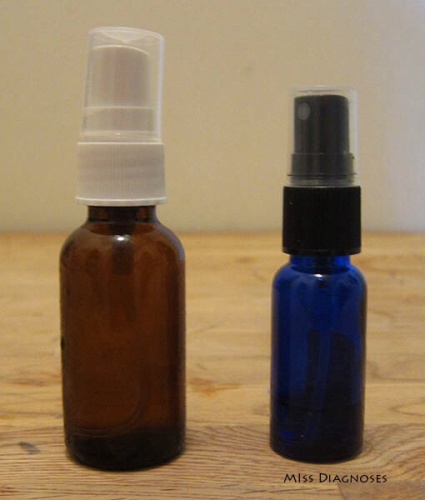I have combination skin, so I always liked the squeaky-clean-face feeling you get from using toner. But after being diagnosed with allergic contact dermatitis, rosacea, Lyme disease, and a genetic defect that weakens my ability to remove toxins, I figured I couldn’t use toner anymore. Commercial brands are packed with irritating ingredients such as alcohol and witch hazel, as well as toxins and allergens such as fragrance chemicals and propylene glycol.* I resigned myself to oiliness, pores like moon craters, and breakouts.
Then I discovered this concoction. There are recipes for it all over the Internet, because green tea’s anti-inflammatory and astringent properties really help battle redness, oiliness, and blemishes. Green tea is also a great antioxidant, and the extract form is often found in antiaging creams. (I don’t know whether the tea concentration in a toner is sufficient to fight wrinkles—it can’t hurt, though.)
As for apple cider vinegar, it contains malic acid, which has antimicrobial and antifungal properties. ACV is good for restoring the skin’s naturally acidic pH and calming breakout-prone skin. It seems to have helped my seborrheic dermatitis, a condition associated with a species of yeast, malassezia, that lives on the skin (lovely, I know). And according to various sites, Scarlett Johansson washes her face with it, making it a Bona Fide Celebrity Beauty Secret. Oh boy!
The recipe I use is very simple, and it’s based on the recipe from The Nourished Life. The original uses about three parts of tea to one part vinegar, but because of my ridiculously sensitive skin, I use about 10 parts of tea to one part vinegar.
About the tea: I used to make this with regular supermarket teas. Then I read this scary article shared by Elizabeth of E.M. and M.E. (a great ME/CFIDS blog that’s also helpful for people doing the low-histamine Autoimmune Paleo diet). The article’s author talks about, among other things, pesticides and GMOs in popular tea brands and plastics in teabags that may start to break down in hot water. Oh, great!
I started using looseleaf organic tea from my local health food store or Rishi brand (which is expensive, but I drink a lot of green tea as well as make this toner). I also bought a tea infuser. There are a ton of metal tea infusers out there, but if you are allergic to nickel like I am, there are all-glass ones like this too. If you use bagged teas, the author recommends certified organic, GMO-free brands such as Numi. I have used Haiku as well. The author also recommended Traditional Medicinals, but I couldn’t find a plain green tea in their line. I prefer plain green teas, such as sencha, for this toner. Flavors like mint, lemon, lemongrass, and jasmine are great for drinking, but for putting on your face? Not sure about that.
You will need:
- Organic looseleaf plain green tea or 1–2 teabags
- Tea infuser or mug
- Distilled water (Distilled water goes through a rigorous filtration process to remove contaminants; spring water is sometimes just repackaged tap water, and it can contain lovely things like arsenic and coliform bacteria.)
- Apple cider vinegar with the “mother” (the nasty-looking stuff at the bottom) such as Braggs
- Small glass spray bottle or lidded bottle (see below). Whole Foods and some health food stores carry the spray bottles, or you can order them from Amazon. Unfortunately Amazon does not seem to sell them singly.
- Organic cotton pads

Heat distilled water until it starts to boil and brew a very strong batch of tea. Chill in the refrigerator.
Add a small amount of apple cider vinegar to the bottle. I usually pour in the vinegar until there’s about 1/8–1/4 of an inch at the bottom, but if your skin is less sensitive you might be able to handle more. Or you could start with a little and build up.
Pour the chilled green tea into the bottle until the bottle is filled. You’re done!
I spritz it on my face and neck and then blot the excess with a cotton pad. I used to make it with a regular lidded bottle and apply it with cotton like regular toner, but the spritzing thing is very refreshing in the summer.
A note about how long to keep it: I have seen everything from “leave it in a cool dark place for a month” to “don’t keep tea for more than one day and leave it in the refrigerator.” I make a new batch every other day and keep it in the refrigerator. This seems to work best for me, as I am not using enough apple-cider vinegar to really preserve it. (And having things growing in it seems less than optimal.)
Variations:
- Green tea toner with Vitamin E and essential oils
- Green tea toner with sea salt from acne.org
- Green tea and apple cider vinegar toner with jojoba or grapeseed oil and vitamin E
- Apple cider vinegar and water toner
- Apple cider vinegar, water, and tea tree oil toner
Now for more DIY: I have recipes on my Pinterest boards and The Allergista has some more. My blog buddy ZenThyroid has a fantastic coconut-oil based moisturizer recipe. Also, blogs like The Nourished Life, Crunchy Betty, Wellness Mama, One Good Thing by Jillee, and Art and Practice have a lot of great recipes. (Note: A lot of DIY recipes have essential oils, which can be irritating. I leave them out all the time without altering the quality of the product.)
*Propylene glycol is an organic alcohol often used as a skin-conditioning agent and humectant. It’s associated with irritant and allergic contact dermatitis, immune system toxicity, and contact urticaria (hives); sensitization effects can occur at concentrations as low as two percent. Topical application to highly injured skin (such as in burn creams), has sometimes been linked to kidney failure, among other things. Sources: Environmental Working Group, Centers for Disease Control, and Ruth Winter, A Consumer’s Dictionary of Cosmetic Ingredients.




I’ve waged years long battles with skin issues. I should try this one.
Given all of the information that is out there and flies around the web, I love that you include these extra reference links because it provides me with more information, and demonstrates how many others are using similar recipes, or variations on the theme. If you’re like me, when you start finding these, it’s like jumping down that proverbial rabbit hole. I guess if I want to try your toner, I better get past my weird dislike for apple cider vinegar. Or hold my nose when applying.
LikeLiked by 2 people
It is very much like jumping down the proverbial rabbit hole! 😉 I forgot to include plain green tea toner … if you hate the apple cider vinegar smell plain tea can help. Also, the apple cider vinegar smell disappears quickly.
LikeLiked by 1 person
Very nice. It’s always good to have natural alternatives.
LikeLiked by 1 person
Thanks! 😀
LikeLike
Sounds interesting. I have the opposite problem of my skin always being dry (maybe related to my thyroid). Who the heck knows. Love when you can make your own connections and they actually work!
LikeLiked by 1 person
Ha, I have dry skin on my body, which is definitely from my thyroid, but my face (especially the T-zone) gets oily, especially in the summer because of the rosacea and seborrheic dermatitis. I got into the DIY thing when I was diagnosed with allergic contact dermatitis in 2010. When I found out about the Lyme and the MTHFR mutation in 2013, I started trying to find recipes for the least toxic products possible, whereas before I was just trying to avoid allergens. A lot ot the concoctions I made were kitchen disasters (imagine globs of shea butter and aloe hitting the wall), but I’m not going to post those. 🙂 I figured a lot of people with Lyme, fibromyalgia, ME, environmental illness, allergies, autoimmune disease, etc. are looking for less toxic beauty products, so I thought I would link to as many other blogs as possible so people could have options. The one thing I noticed is that a lot of recipes have essential oils, and if you don’t use organic ones they can have pesticides, and I also don’t know how safe the extraction process is.
LikeLike
I love this! Another awesome recipe that I can’t wait to try. We definitely need to get together for a DIY spa day 🙂 Thanks for including me in your post – you are the sweetest. The little glass bottle are super cute so I think I have to make this just for the bottles.
LikeLiked by 1 person
Ha, the bottles are fun! Yes, we must do a DIY spa day! Yay!!
LikeLike